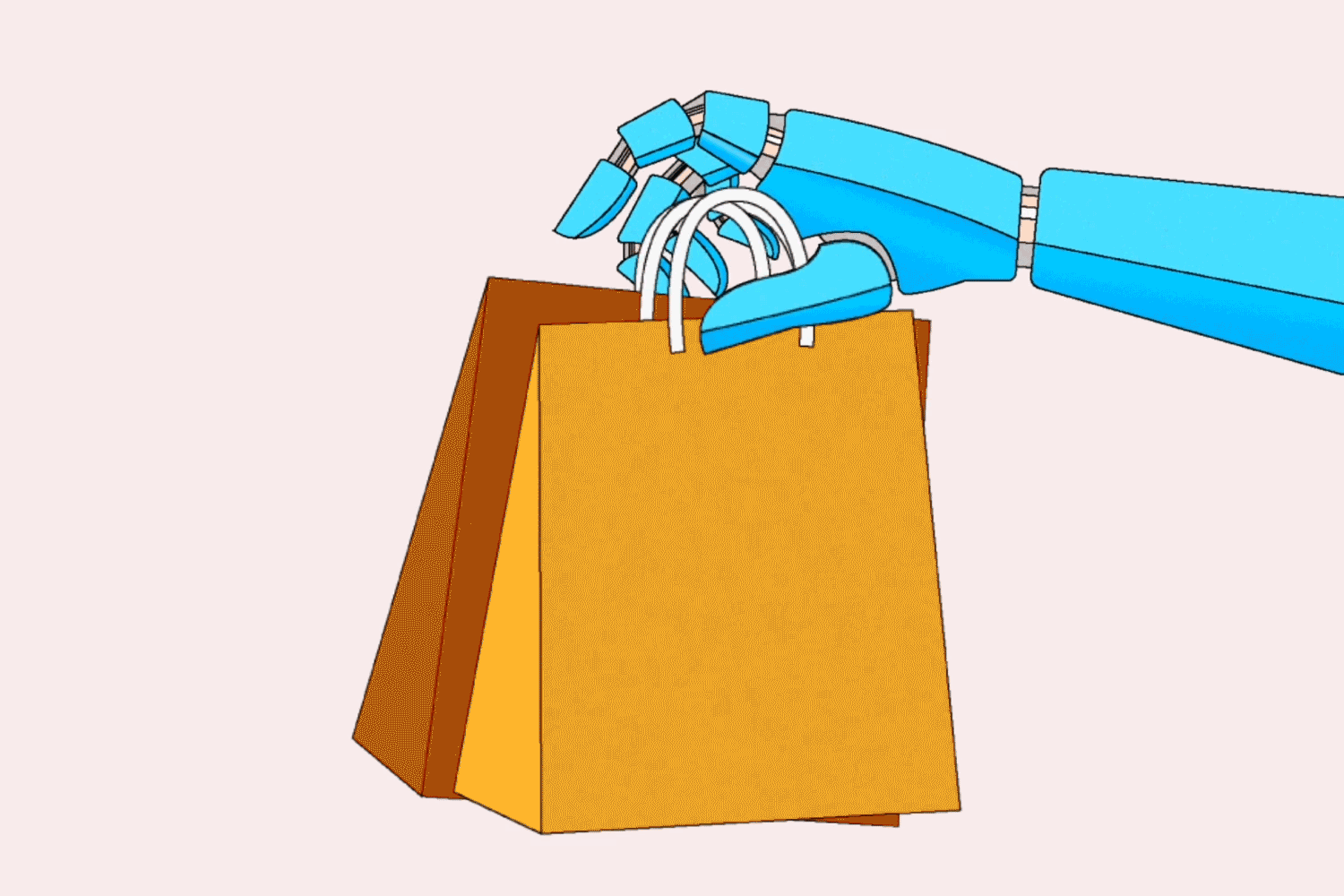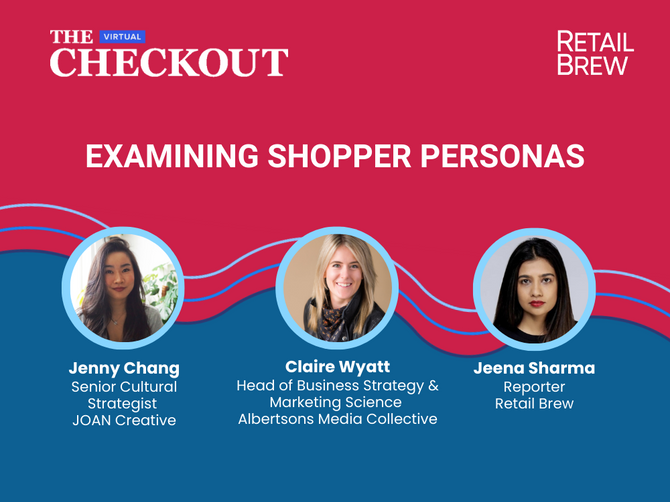Happy Tuesday! We hope you enjoyed the three-day weekend and got to take advantage of some beautiful weather. Sadly, we won’t have another Monday off until Memorial Day. Only 97 days to go!
In today’s edition:
—Maeve Allsup, Katishi Maake, Alyssa Meyers
|
|
Amelia Kinsinger
If you’re hearing a lot of chatter about artificial intelligence in your local coworking space, gym, or bar this week, it’s probably in the context of conversational chatbot ChatGPT.
But asking the very impressive conversational AI to write a breakup text—while admittedly amusing—is far from the only (or best) use of artificial intelligence. In fact, when you’re in a grocery store, online shopping, or at the mall, you’re probably surrounded by AI without even realizing it.
The retail industry is a major arena for AI implementation: According to a study by Precedence Research, the global AI in retail market, which was worth $8.41 billion in 2022, is projected to soar to nearly $46 billion by 2032.
While there’s still plenty of room for growth and improvement in artificial intelligence overall, it’s already proving its value in key everyday retail use cases.
Customer service
The Precedence study also found that customer relationship management is one of the top use cases for AI in retail, making up 21.5% of overall market share in 2022.
That includes things like customer service chatbots, which can either connect customers to support teams or respond to questions in real time. Brands from Sephora to Taco Bell have been experimenting with AI in customer service for quite some time, including through Facebook Messenger assistants, shopping concierges, and WhatsApp chatbots.
Overall, artificial intelligence in customer service offerings can help retailers cut down on labor costs, and increase consumer satisfaction by decreasing wait times and providing constant availability.
Product recommendations
Recommendation AI is another key investment for the retail world. We’re talking personalized product recommendations at scale, based on everything from browsing and shopping history to chatbot interactions.
Keep reading here.—MA
|
|
|
Believe it or not, D2C brands may be perfectly positioned to reach new revenue heights this year. How? By doing more with less.
Join Bloomreach’s Commerce Experience Summit. This one-of-a-kind, 2-day digital event will bring together D2C industry experts and thought leaders to discuss maximizing profit in 2023—no matter what the economy’s got up its sleeve.
From beating the CAC crunch to personalization, you’ll learn about real revenue-boosting tactics from Bloomreach, Google Cloud, Antavo, and Gorilla Group (to name a few!).
Understanding this year’s changing landscape is crucial. The expert panel will dive into the latest shifts in consumer behavior and purchase patterns in digital commerce.
Give the revenue battles a rest and register today.
|
|
From left to right: Lovot, Ballie, Rollbot, Digit, Alphabot. Image by Francis Scialabba
If ChatGPT has taught us anything, it’s that people like quick solutions to their problems. Retailers across the spectrum are upping their tech, using robots in particular, to better cater to the needs of consumers. But how widespread exactly is robot-human interaction in a shopping context?
As Retail Brew has covered, retailers are using robots to automate tasks and processes on the back end to streamline their operations, but consumers are interacting with robots and technology in their day-to-day shopping experiences at a less frequent pace than retailer adoption. It’s a gap that retailers want to close for technological investments to pay off.
Do the robot: When thinking about their shopping experiences, nearly half of Americans (45%) report engaging with a chat box or other AI technology when seeking out customer service, according to a Harris Poll/Retail Brew survey of 2,080 US adults. However, less than half of respondents (48%) agree that robots could improve in-person shopping.
- Almost a quarter (23%) report sometimes or often seeing robots during their shopping experiences.
- Fewer respondents report sometimes or often receiving food deliveries to their residence by robot or drone.
- But a majority of shoppers believe robots could improve food (57%) and non-food (62%) delivery services.
Quick flashback to a 2021 Harris Poll/Retail Brew survey that found only 30% of respondents said they want more technology integrated in their shopping experience, while a majority (57%) wanted less, or for it to stay the same.
In 2023, Americans believe robots are most useful in supply chain and fulfillment processes (31%), followed by delivery services (21%), customer service (11%), and purchasing products (10%). However, roughly a fifth (21%) believe that robots would not be useful anywhere in the shopping experience.
Keep reading here.—KM
|
|
MARKETING
Insert [ad] here
|
Illustration: Dianna “Mick” McDougall, Photo: Tanja Ivanova/Getty Images
“Ever opened a package and found—tucked away with the new clothes you definitely don’t need—a flier for yet another product you probably don’t need? That’s known as insert media. The channel is not exactly new, but it’s experienced something of a ‘renaissance’ over the past two or three years,” writes Marketing Brew’s Alyssa Meyers:
Interest in inserts has been “pretty steady for a long time,” [Eric Smith, VP of emerging media at offline marketing company Incremental Media] told us, but a few factors can help explain its recent resurgence. “Search is more expensive than it used to be, and social isn’t converting as well,” he said. “Brands are looking for new [channels], and so what’s old is new again.”
Keep reading here on Marketing Brew.
|
|
|
Retail media is booming. It’ll top $50b by the end of 2023, but platforms still rely on outdated attribution to understand what’s working. Tradeswell uses predictive analytics to isolate only the incremental impact of your retail media campaigns so you can better optimize your spend. Learn how to unlock your incremental growth.
|
|
Today’s top retail reads.
New roads: While no single country can match China’s manufacturing capabilities, some companies are considering a patchwork of Asian economies as an alternative. This “alternative Asian supply chain” includes parts of Japan, South Korea, Taiwan, the Philippines, Indonesia, Singapore, Malaysia, Thailand, Vietnam, Cambodia, Bangladesh, Laos, Brunei, and India. (The Economist)
Bread and butter: The end of a pandemic-era boost to food stamps worth $98 billion could be problematic for dollar stores and supermarkets, where food stamps account for more than 10% and 20% of sales, respectively. (the Wall Street Journal)
Booksmart: The surprising, triumphant return of Barnes & Noble involved reassessing the mix of products on shelves, and bringing the focus back to…books. (Los Angeles Times)
Keep ’em comin’ back: Yeah, yeah, easier said than done. But this report from Recharge should help, since it details how subscriptions performed in 2022 and offers tactics on how to get ahead. Download it here.* *This is sponsored advertising content.
|
|
Want to know the secret to keeping your customers coming back? Hint: it lies in how deeply you understand them. For more insight, join us on 2/23 at 12pm EST for a free virtual event, sponsored by Bolt. We'll chat with industry experts, hear key findings from Bolt's report on shopper personas & more!
Sign up today
|
|
-
Kroger and Albertsons will face an investigation by the Arizona attorney general over their proposed merger.
-
PepsiCo issued a voluntary recall of more than 300,000 Starbucks coffee drinks after glass was found in some bottles.
-
Nike’s chief digital information officer, Ratnakar Lavu, resigned on Monday. He had served in the role since 2019.
-
Yeti’s interim CFO, Mike McMullen, will serve in the role permanently, the company said.
-
The RealReal said it would lay off 7% of staff and close several stores and consignment offices.
-
Etsy is under fire after Citron Research reported the marketplace is one of the largest platforms for counterfeit goods.
|
|
What happened in the world of retail this week in…1906 and beyond? Retail Brew takes you way, way, way back.
- On February 19, 1906, William Keith Kellogg founded the “Battle Creek Toasted Corn Flake Company.” He wisely rechristened it the Kellogg Cereal Company in 1922.
- On February 19, 1985, Coca-Cola introduced Cherry Coke.
- On February 20, 2009, the Hershey Company closed the Pennsylvania plant where York Peppermint Patties had long been produced. Production was moved to a newly constructed facility in Monterey, Mexico.
- On February 24, 1955, Steve Jobs was born in the region that would become Silicon Valley. We hear he came out of the womb in a black turtleneck.
|
|
Catch up on the Retail Brew stories you may have missed.
|
|
|
Written by
Maeve Allsup, Katishi Maake, and Alyssa Meyers
Was this email forwarded to you? Sign up
here.
Take The Brew to work
Get smarter in just 5 minutes
Business education without the BS
Interested in podcasts?
|
ADVERTISE
//
CAREERS
//
SHOP 10% OFF
//
FAQ
Update your email preferences or unsubscribe
here.
View our privacy policy
here.
Copyright ©
2023
Morning Brew. All rights reserved.
22 W 19th St, 4th Floor, New York, NY 10011
|
|









